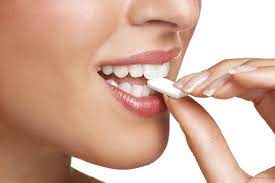From gnawing on birch bark to smacking on several contemporary gum brands, chewing gum has been proven to lower levels of tooth decay occurrences. Chewing gum has been a popular habit throughout history and as product advancements have been made, more individuals have gotten into the action to improve their dental health.
Annually humans ruminate 100,000 tons of chewing gum and the world wide habit generates $19 billion in sales each year as a result. There are dozens of different manufactures who produce the confectionery delight, which comes in a huge array of flavors including mint, cinnamon, bubblegum, fruit, floral, chardonnay and many more. Depending on what type of gum a consumer chooses, the treat can help boost dental care.
History of Chewing Gum
For five thousand years, humans have been chewing on substances similar to traditional chewing gum. Archeological digs have unearthed gum-like substances dating back to 3000 BC traced to when Neolithic people chewed lumps of birch bark tar. In Ancient Greece, individuals smacked on mastic tree resin. Native Americans also used to chomp on resin made out of the sap of birch trees.
Those early practices helped pave the way for the chewing gum industry and in 1848, John B. Curtis took a cue from Native Americans and created the very first commercial gum called The State of Maine Pure Spruce Gum. Once paraffin wax was created circa 1850, it replaced spruce gum. However it was the introduction of Mexican chicle (a natural chewing gum made by a species of evergreen tree) in the 1860s that laid the groundwork for the chewing gum industry of today.
Chicle was first introduced as a rubber substitute and while it was rejected from that industry, its chewable and non-toxic nature was perfect for candy manufactures. In 1869 Thomas Adams invented modern chewing gum using the substance to launch the chewing gum industry. Adams learned of chicle courtesy of his position as the secretary to former Mexican leader, Antonio Lopez de Santa Anna. He chewed on chicle and Adams took that substance, added sugar and created the forerunner for the popular gum called Chiclets. Once Adams figured out the how, other businesses jumped on the chewing gum bandwagon.
Gum Chewing for Dental Health
Some people favor chewing gum to eliminate bad breath, help them quit smoking or even as a diet aid. Aside from those benefits, choosing the right kind of sugar free chewing gum can actually boost dental health and reduce the odds of developing tooth decay and dental cavities.
Chewing gum can help an individual increase their saliva production. Saliva is that clear, liquid substance comprised of water and enzymes and is essential to the digestion process. As saliva production increases, the liquid will lower the amount of sugars and foods deposited on teeth. Those compounds are what oral bacteria feast on and when they do, they will band together to form plaque and produce acid as a byproduct. That acid is the culprit behind dental problems such as tooth decay and gum chewing can help it all balance out.
In addition to the body’s own system, contemporary gum manufactures have been adding ingredients that have been scientifically proven to improve dental health including:
- Antibacterial agents developed in 2005 have be added to gums to replace traditional oral hygiene methods for military personnel in need. Additionally, U.S. Military staff has been chewing gum with government approval since WWI as the product was found to help relieve stress while improving concentration levels.
- CaviStat has been designed to mimic the cavity-fighting benefits of saliva. Research has found that children who chewed the substance for a 12 month period year had significantly less cavities in their molars than the children in a placebo group in the study.
- Xylitol is natural sweetener that has been proven to reduce levels of oral bacteria known for causing tooth decay.
- Recalden is a type of calcium derived from milk. Rumor has it that this ingredient can help strengthen and rebuild tooth enamel. Chewing Gum Risks
Chewing gum is not without risks and constant mastication can cause problems including:
- Damaging dental work as some extra sticky gums can adhere to braces, fillings, bridges and dental crowns. Individuals who use force to remove the compound may accidentally loosen or break the dentistry efforts.
- TMJ (Temporo-Mandibular Joint) is a condition the “…joint connecting your lower jaw to your skull” and can cause pain and discomfort. The repetitive nature of gum chewing can exasperate the issue.
- Tooth decay is probable for individuals who chew sugary gum not sugar-free options.
Individuals looking to chew gum to improve their dental health need to choose wisely, chew in moderation and never think that the process can replace oral hygiene. Instead, gum chewers must conduct their due diligence in regards to brushing, flossing, eating a nutritious diet, drinking clean fresh water and partaking in regular dental visits complete with exams and cleanings.

